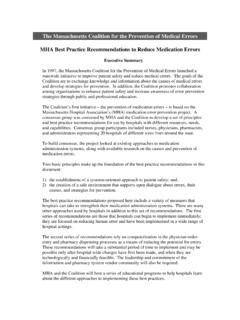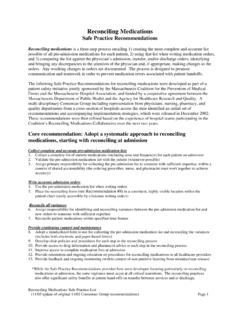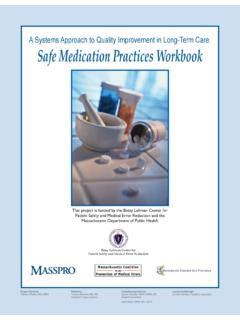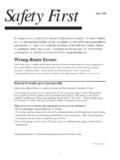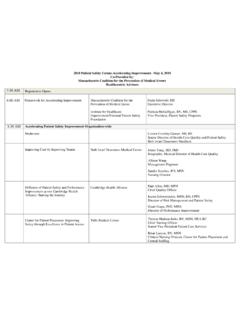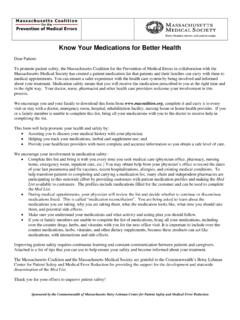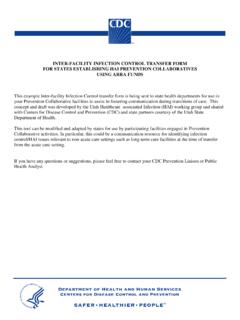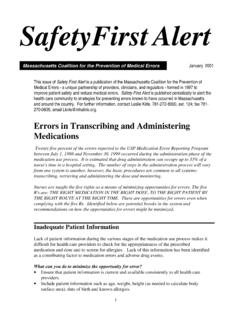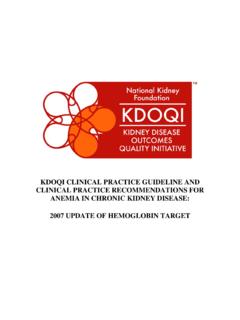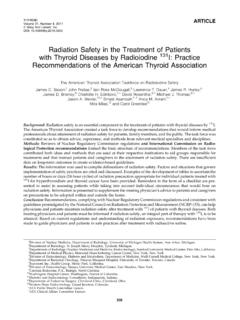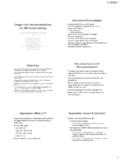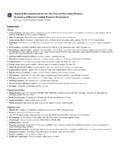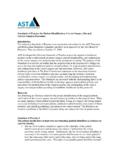Transcription of Communication Critical Test Results Safe Practice ...
1 Communication Critical Test Results safe Practice recommendations The following version of the Coalition s safe Practice recommendations was published in the February 2005 issue of the Joint Commission Journal on Quality and Patient Safety. The Journal has generously given us permission to post the PDF file on our webpage and it follows below. The Joint Commission Journal on Quality and Patient Safety provides many helpful articles and specific applications for quality improvement and patient safety projects. The February 2005 issue includes several additional articles on Communicating Critical Test Results : Introduction: Communicating Critical Test Results Issues and Initiatives in the Testing Process in Primary Care Physician Offices Failure to Recognize and Act on Abnormal Test Results : The Case of Screening Bone Densitometry Diagnostic Errors in Medicine: A Case of Neglect The journal is available both in print and on-line.
2 For subscription information click on the following link: 68 February 2005 Volume 31 Number 2 Massachusetts hospitals have collaborated in astatewide patient safety initiative aimed atimproving our ability to communicate criticaltest Results in a timely and reliable way to the clinicianwho can take action. This topic was selected in March2002 by an advisory group of hospital representativesconvened by the Massachusetts Coalition for thePrevention of Medical Errors (the Coalition) and theMassachusetts Hospital Association (MHA). There wasbroad consensus that errors in the process of communi-cation of test Results were both frequent and had thepotential for serious harm.
3 Solutions to this problemwould address enhancing Communication , teamwork,and information transfer, all fundamental system factorslinked to patient safety. The Coalition and MHA convened a multi-disciplinarystakeholder group that included representation fromthe laboratory, cardiology, radiology, and physiciansand nurses from inpatient and ambulatory sites. ThisConsensus Group met monthly from early June 2002through early February 2003 to identify guidelines,implementation issues, and useful strategies toimprove Communication processes. The group definedcritical test Results as any values/interpretations for which delays in reporting can result in serious adverse outcomes for patients.
4 The scope included laboratory, cardiology, radiology, and other diagnostictests in the inpatient, emergency, and ambulatory Consensus Group developed two major products: safe Practice recommendations to promote successfulCommunicating Critical TestResults: safe Practice RecommendationsCommunicating Critical Test ResultsDoris Hanna, , , Griswold, L. Leape, W. Bates, , :Massachusetts hospitals have collabo-rated in a patient safety initiative conducted by theMassachusetts Coalition for the Prevention of MedicalErrors and the Massachusetts Hospital Associationwhich is aimed at improving the ability to communicatecritical test Results in a timely and reliable way to theclinician who can take action.
5 Solutions to this prob-lem would address enhancing Communication , team-work, and information transfer, all fundamental systemfactors linked to patient safety. Developing the safe Practice recommendations and the Starter Set :A Coalition-convened Consensus Groupdefined Critical test Results as values/interpretations forwhich reporting delays can result in serious adverse out-comes for patients. The scope included laboratory, cardi-ology, radiology, and other diagnostic tests in inpatient,emergency, and ambulatory settings. The ConsensusGroup developed safe Practice recommendations topromote successful Communication of Results , and a starter set of test Results sufficiently abnormal to bewidely agreed to be considered Critical .
6 Dissemination:The recommendations and thestarter set of test Results were disseminated in astatewide collaborative open to all Massachusetts hos-pitals. Hospitals team members tested changes andshared successful strategies that improved the reliabili-ty of communicating Critical test Results . An evaluationof the Results of this collaborative is 2005 Volume 31 Number 2communication of these Results , and a starter set oftest Results sufficiently abnormal to be widely agreed tobe considered Critical . The safe Practice recommendations address thefollowing: Who should receive the Results Who should receive the Results when the orderingprovider is not available What Results require timely and reliable Communication When the Results should be actively reported to theordering provider with explicit time frames How to notify the responsible provider How to design, support, and maintain the systemsinvolvedAlthough all hospitals had thresholds regarding whichresults to communicate, these nearly always includedmany Results that were not truly Critical , thus greatlyincreasing the number of calls and diluting the sense ofurgency with which their Communication was receivedby physicians.
7 On the other hand, some abnormalitiesthat were not emergent yet could not be lost withoutserious consequences were not included. As a result,we developed a starter set for test Results /interpretationsthat organizations could use. This set will certainlyrequire additional refinement and we present it as aplace to recommendations were disseminated in astatewide collaborative open to all Massachusetts hos-pitals. Hospitals working on this project met togetherin four collaborative sessions (May and November2003 and March and September 2004) in a 16-monthperiod to learn how to implement these recommenda-tions. Using the Institute for Healthcare Improvement sModel for Improvement, team members testedchanges, relied on measurement to monitor theirprogress, and shared successful strategies thatimproved the reliability of communicating Critical testresults.
8 An evaluation of the Results of this collabora-tive is currently underway. The safe Practice recommendations can be found inTable 1 (page 70 76). References for the safe PracticeRecommendations follow. The Rationale and OperatingDefinitions for Communicating Critical Test Results can befound in Appendix 1 (pages 78 79). An excerpt limited tothe laboratory testing areas of chemistry and blood gasesfrom the Consensus Group recommendations for StarterSet Values/Interpretations can be found in Appendix 2(page 80). These values and interpretations are not intend-ed to serve as a standard but rather as a starting point forhospitals own determination of values and interpretationsappropriate to the populations served.
9 This work was supported by a grant from the Agency for HealthcareResearch and Quality to the Massachusetts Department of Public Health(5 U18 HS11928). The authors gratefully acknowledge the work of EricG. Poon, , , in the development of the Starter Set ConsensusGroup recommendations for Starter Set Values/Interpretations forthe Red, Orange, and Yellow Categories from Laboratory, Radiology,Cardiology, and Hanna, , , ,is Consultant,Massachusetts Coalition for the Prevention of MedicalErrors, Boston, and Paula Griswold, ExecutiveDirector, Massachusetts Coalition for the Prevention ofMedical Errors, Boston. Lucian L. Leape, AdjunctProfessor of Health Policy, Harvard School of Public W.
10 Bates, , ,is Chief, Division of GeneralMedicine, Brigham and Women s Hospital, and MedicalDirector, Clinical and Quality Analysis for PartnersHealthcare System, Boston. Please address reprint requeststo Doris Hanna, 2005 Volume 31 Number 2 safe Practice Recommendation The primary responsibility for receivingand following up on test Results lieswith the ordering provider or theresponsible provider as appropriate Test Results must be reported directly toa provider who can take action, not anintermediaryFor red category values/interpretations,notify the nurse caring for a patient on theinpatient unit simultaneously Develop a procedure to link eachpatient with either a provider or a service at the time of admission A patient should be linked at all times witha provider (or Practice )
